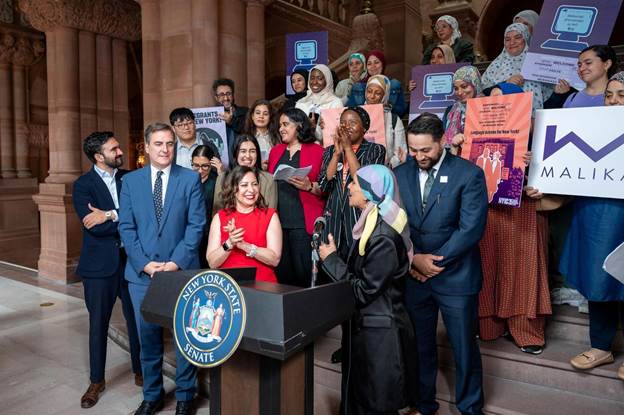New York City will close by late February the controversial migrant shelter it built on Randall’s Island to handle the overwhelming flow of newcomers over the past two years, City Hall announced on Wednesday.
The city has already started deconstructing the 3,000 bed shelter for adult migrants, according to City Hall, having already deconstructed the largest tent that housed 750 people. The Randall’s Island shelter, which was built in the summer of 2023, is of several large-scale facilities Mayor Eric Adams’ administration threw up over the past two years to handle 200,000 plus migrants who have continued to arrive in the five boroughs.
Mayor Adams, in a statement, said the city has “turned the corner” in the migrant crisis that was once overwhelming his administration both logistically and financially.
“We’re not scrambling every day to open new shelters — we’re talking about closing them,” the mayor said. “We’re not talking about how much we’re spending — we’re talking about how much we’ve saved.”
Adams added that the city will work to restore the athletic fields where the shelter was erected, once it has been taken down.
The city is moving to close the shelter because the need for such a facility is waning as the number of migrants entering the city has percipitously dropped over the past few months, according to the mayor’s office. The decrease followed President Biden issuing executive orders in June cracking down on the number of illegal border crossings, Adams administration officials have said.
“With 14 straight weeks of lower numbers of new arrivals seeking asylum, we are now able to transition from this large humanitarian relief center, which is a step in the right direction,” said Deputy Mayor Anne Williams-Isom, who has led the city’s migrant crisis response, said in a statement.
The drop in new arrivals, coupled with the city’s 30—and 60-day shelter stay limit policies, has decreased the number of migrants in city shelters from close to 70,000 late last year to a little over 60,600 as of Oct. 6.
The Randall’s Island shelter was a magnet for controversy even before it opened last year.
At the time, the Randall’s Island Park Alliance, a group that runs the island’s park lands, urged the city not to build the facility on its athletic fields. The group argued that using the fields for migrant housing would cancel over 3,000 permit hours for youth, adolescent, and adult sports leagues that utilize the fields—mostly for soccer.
The site continued to draw backlash over the past year over a few instances of violence amongst newcomers living there as well as minor encampments and open-air markets that have sprouted up around it.
Some immigrant advocates, who were broadly against the city’s use of tent-like shelters, celebrated the impending end of the Randall’s Island facility.
Murad Awawdeh, president and CEO of the New York Immigration Coalition, called the announcement “welcome news.”
“Cramming people into congregate settings in tents – in locations far away from public transportation, grocery stores and jobs – has been a recipe for failure since day one,” Awawdeh said. “It is welcome news that the city will be closing the Randalls Island [shelter].”
But Awawdeh noted the city must still move close to its other large-scale tent shelters, especially the one that houses families at Brooklyn’s Floyd Bennett Field.
Read More: https://www.amny.com/politics/






































